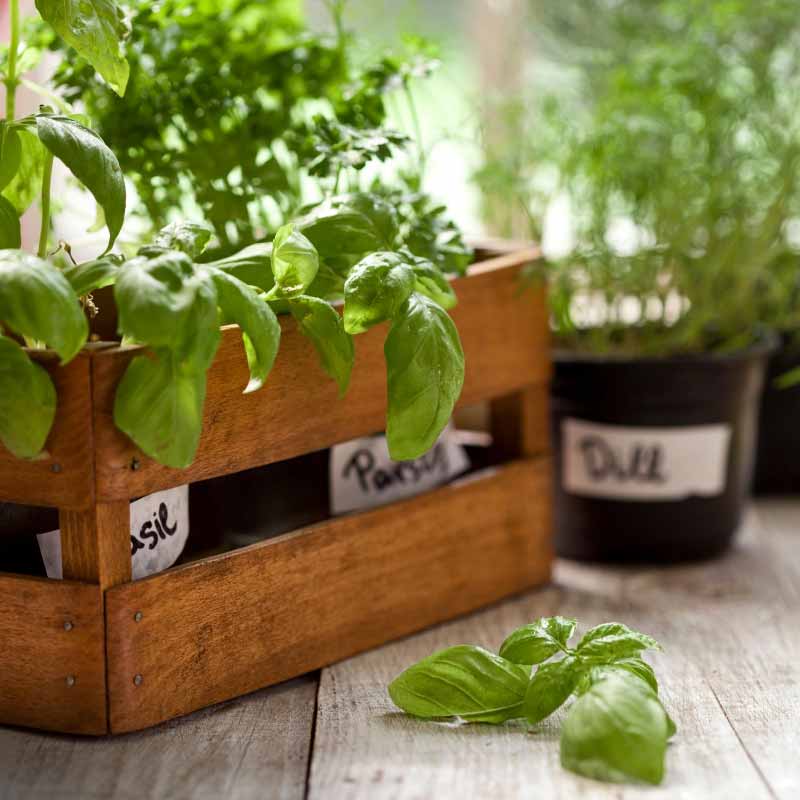Grow an Indoor Herb Garden – Why & How?
Why grow an indoor herb garden? That’s an easy question to answer.
There are many benefits for everyone. Here are just a few!
Many people find gardening an enjoyable activity. For seniors, who may have been caregivers most of their lives and are now experiencing role reversal, gardening offers a sense of purpose. Older people who have reduced mobility also find it easier to care for an indoor garden.
Gardening has great mental health benefits. Studies show that being immersed in nature is good for us. It can reduce stress, alleviate symptoms of depression, and encourage relaxation. Growing plants also promotes a sense of satisfaction and accomplishment, especially when we can eat the end result.
Children also reap the benefits of growing an indoor herb garden. They can develop their numeracy and analytical skills. For example; ask them to determine where the pots need to be placed to receive the most sunlight. Ask them to work out how many seedlings can be planted in a 20 cm pot if seedlings are to be planted 5 cm apart. Gardening is a great platform where children can learn more about patience and responsibility.
Convinced, and eager to grow an indoor herb garden? Here’s how…
- Select the right size pots for your indoor herbs. Think about which herbs you want to grow and consider this when choosing the size of your pots. Creeping herbs such as thyme have shallow roots and flourish in a shallow pot. Herbs such as basil have long roots and prefer a deeper pot.
- Grow each type of herb in a separate pot. This gives you flexibility to create the perfect environment for each individual herb. For example, one may prefer more watering than another.
- Use a premium potting mix for indoor herbs. Check the packaging on the potting mix to ensure it is a light mix suitable for growing herbs indoors.
- Provide lots of light. Remember, to a plant, light is food. Herbs thrive with 6-8 hours of sunlight. Light also contributes to the flavour of your herbs, so the more light the better. When placed next to a window, ensure the leaves are not touching the glass. The leaves could burn as the glass heats up. It’s also a good idea to take your pots outside now and then for direct sunlight and fresh air.
- The ideal indoor temperature should be around 15–21 degrees Celsius. This suits most homes. The fussiest herb to grow indoors is basil. It prefers the warmth and does not like to get too cold.
- Don’t over-water your herbs. Allow the soil to dry out between watering. You can check the soil with your finger to know when to water. If the soil feels dry at about 5 cm below the surface, then it’s time to water. Pour the water in slowly so the soil has a chance to absorb it. Also, if you have a saucer under your pot, remove it until the water has finished draining. Herbs do not like to sit in water. Take care to water the soil, not the plant’s leaves.
- Feed herbs with a seaweed or fish-based fertiliser. These types of fertilisers are high in nitrogen which is great for strong leafy growth. You can fertilise once a week during active growth, and reduce this to once a month for slower growth periods. Trim herb leaves regularly to encourage thicker, compact growth.
- Provide good air circulation, give them space to breathe. If your herb pots are too close together, they won’t receive enough airflow. This can increase the risk of spreading disease.
It won’t take long for your herbs to be ripe for the picking. Add them to any one of hundreds of delicious recipes, and get ready to cook up a storm!
Simply Helping provides a range of home care services that can help you in the kitchen, and assist with meal preparation. Visit Our Locations page to find a Simply Helping team near you.





